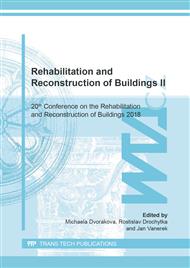p.9
p.15
p.27
p.33
p.39
p.46
p.60
p.66
p.75
Analysis of Reconstruction in Terms of CO2 Concentration
Abstract:
The paper focuses on the analysis of reconstruction in terms of CO2 concentration. The reconstruction at the university included the exchange of windows. The original windows were exchanged for the modern wood tight windows. Providing CO2 concentration in the interiors of a university is immensely important for the students of the university. Not exceeding CO2 concentration limits is necessary not only for the physiological needs of students but also for the required performance of students. Teaching is conducted during the whole day in the researched university schoolroom. The short-term natural ventilation during the breaks is noticeably not sufficient. After 15 minutes from the beginning of the lesson, students started complaining about the air quality and they had to open the windows. To point out the unsustainable state of the poor air quality during the day-long teaching and to be able to prove the officials the importance of the continuation of the reconstruction by building mechanical ventilation or air conditioning system, there were carried out the experimental measurements in the schoolroom. The device Testo 480 was used for the measurements. Obtained values of CO2 concentration are presented in the charts. Interestingly, this reconstruction significantly decreased the air quality. The admissible values of CO2 concentration were exceeded after the first hours of teaching. These values were worsening with each additional hour of teaching. Therefore, another reconstruction is needed to enable the transition from natural ventilation to the mechanical ventilation system. In the conclusion of this paper, there are principles how to design new schoolrooms. Furthermore, there are presented recommendations how to operate the existing schoolrooms.
Info:
Periodical:
Pages:
39-45
Citation:
Online since:
June 2019
Authors:
Price:
Сopyright:
© 2019 Trans Tech Publications Ltd. All Rights Reserved
Share:
Citation:


